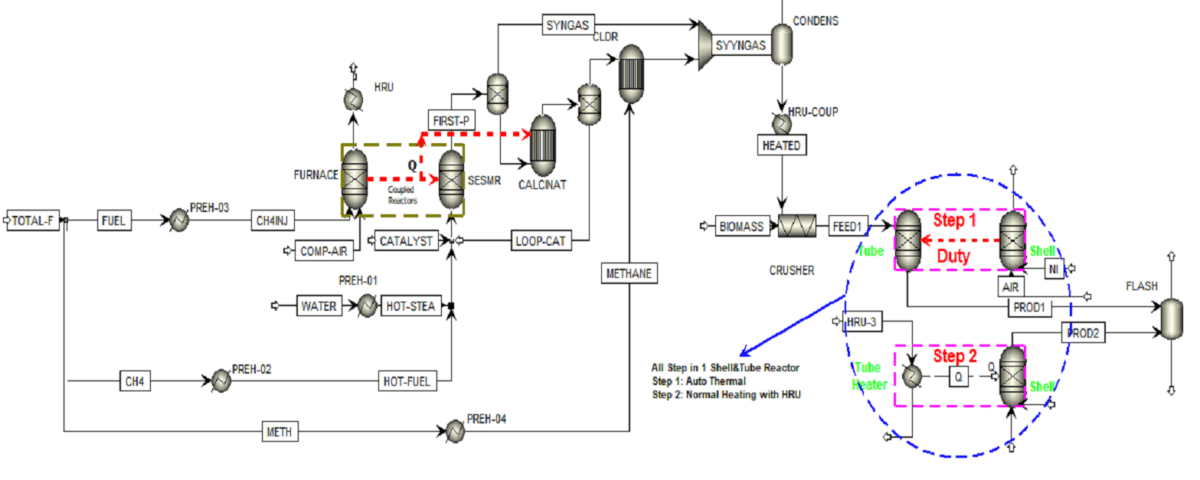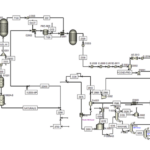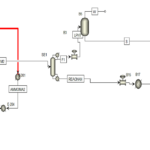Introduction
The world is currently heavily reliant on non-renewable energy sources to meet the growing societal and economic demands of humanity. This reliance on fossil fuels has posed a significant threat to climate change due to the continuously increasing greenhouse gas emissions. In recent decades, the need for clean and sustainable energy sources has become increasingly important due to the rapid growth of the global population and industrial development. Among clean energy sources, synthesis gas has attracted significant attention as an intermediate, producible, and utilizable resource.
Biomass, being a renewable, long-term, accessible, carbon-neutral, and cheaper energy source, has become an efficient feedstock for producing synthesis gas. It also reduces landfill waste by 60-90%. Traditional methods of producing synthesis gas do not meet the environmental sustainability, energy efficiency, and cost reduction requirements. Therefore, extensive research has been conducted to design and implement novel synthesis gas production units using new methods. Dry reforming of methane (DRM), steam-enhanced dry reforming of methane (SESMR), and gasification of biomass are new alternative technologies for producing synthesis gas with high hydrogen purity. This research also aims to design and simulate the production of hydrogen and reduce greenhouse gas emissions using these new technologies.
Process Description
This research, based on the conceptual idea of the process team at FARAYAND SANAT SALINCO, aims to prevent the emission of greenhouse gases that cannot reach equilibrium in the atmosphere.
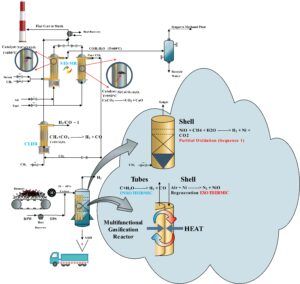
Steam Methane Reforming with Enhanced Absorption
A significant advantage of steam methane reforming with enhanced absorption over traditional steam methane reforming lies in the incorporation of calcium oxide (CaO) catalyst as an in-situ absorbent within the reactor. This eliminates the need for a separate absorption stage, as CO2 is directly captured and converted to solid calcium carbonate (CaCO3). This approach results in a more efficient and cost-effective process for producing synthesis gas while reducing greenhouse gas emissions. The reactor output is fed into a separator, yielding a synthesis gas stream enriched in hydrogen with minimal CO2 from the top and a catalyst bed composed of Ni and CaCO3 from the bottom.
Dry Reforming of Methane in Chemical Looping Dry Reforming (CLDR) Reactors
CLDR reactors represent a significant innovation in synthesis gas production. While both steam reforming and dry reforming are endothermic reactions, the use of CO2 as a reactant has garnered increasing attention due to its potential to reduce greenhouse gas emissions and energy consumption associated with steam removal. Catalysts in these reactors typically consist of cerium, palladium, or platinum oxides supported on alumina. CLDR occurs within a catalyst bed in the absence of steam. Moreover, the following reaction is employed to enhance hydrogen production:
CH4 + CO2 → 2CO + 2H2
This reaction is highly endothermic and proceeds at elevated temperatures. The presence of steam within the reactor can reverse the water-gas shift reaction; therefore, ensuring a dry atmosphere within the CLDR reactor is crucial.
Biomass Gasification Reactor
The multifunctional gasification reactor operates auto thermally, employing a mechanism similar to shell-and-tube heat exchangers. Endothermic reactions occur within the tubes, while exothermic reactions take place in the shell. This configuration significantly reduces the energy requirements compared to conventional gasifiers.
Nickel-based catalysts are employed within the tubes to facilitate partial oxidation reactions. The exothermic nature of nickel reduction provides significant heat, which is transferred to the endothermic reactions within the tubes, analogous to a heat exchanger.
Process Simulation
In this research, Aspen Plus version 14 was employed as the simulation tool. Throughout all simulation stages of this section, equations of state were utilized to estimate thermodynamic properties and the behavior of compounds in gasification processes, separation units, methane reforming, and other sections.
Sensitivity Analysis
A novel design has been introduced that allows for sensitivity analyses of the operating conditions of each reactor and system under study. The impact of variations in temperature, pressure, concentration of substances, and other significant parameters on the performance of reactors and systems is investigated both directly and indirectly. These analyses enable us to implement straightforward optimizations in selecting the operating conditions of each reactor and system.
For instance, examining the sensitivity analysis of temperature in each reactor is a crucial operational condition that must be conducted for every process. Changes in temperature can affect reaction rates and kinetics, process thermodynamics, and material properties. The diagram indicates that the production of gaseous compounds exiting the SESMR reactor exhibits high sensitivity to changes in temperature. This diagram reveals that as the temperature increases within the range of 500 to 800 degrees Celsius, hydrogen production reaches its maximum value. The primary objective of the research is to produce hydrogen and enhance operational and production efficiency; therefore, the optimal temperature for the reactor should be selected based on the hydrogen production rate.
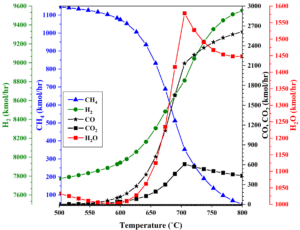
To validate the results of the newly designed process, a simulation of the reformer unit at FAN AVARAN Pet. Co. was conducted using Aspen Plus, version 14. A comprehensive comparison between the newly designed process and the existing reformer unit at FAN AVARAN Pet. Co. was performed. This simulation was carried out using official data provided by FAN AVARAN Pet. Co.

Integrated Process Simulation for Simultaneous Production of Hydrogen and Syngas for Methanol Synthesis
This project presents a process simulation of an integrated plant for the simultaneous production of hydrogen and synthesis gas, with the ultimate goal of methanol synthesis. The simulation was developed using Aspen Plus version 14.
